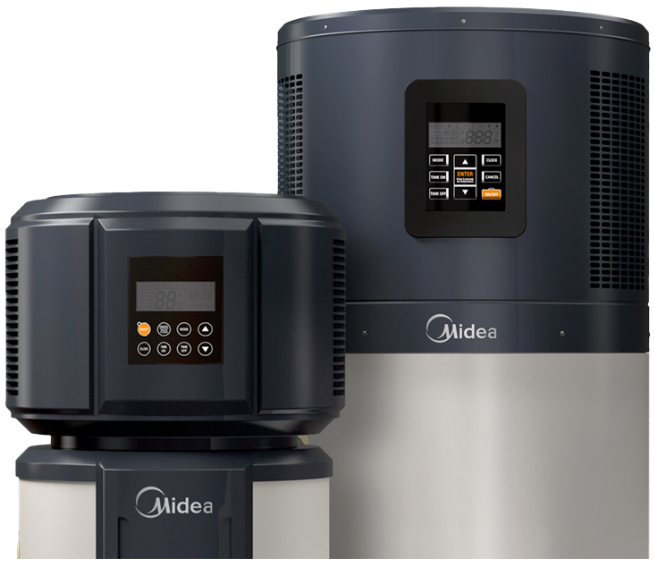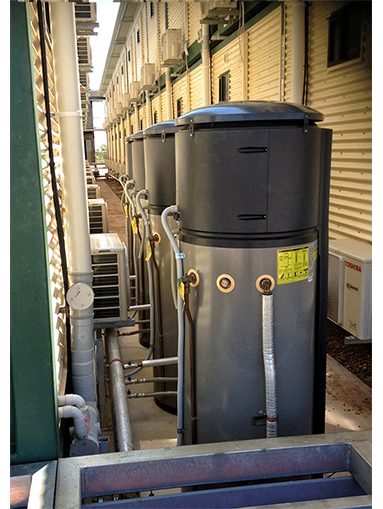Heat Pump Hot Water System

Heat-pump hot water systems
Heat-pump hot water systems use a refrigeration cycle to extract heat from the surrounding air. They then use a heat exchanger to heat water in an insulated storage cylinder. These systems typically use around 60 to 75% less electricity than a conventional electric hot water system. This is because the electricity is used to operate the heat pump and doesn’t heat the water directly with an element.
These systems work in a similar way to reverse-cycle air conditioners when run on a heating cycle, but heat water instead of the air inside your home.
A heat-pump hot water system can be thought of as a type of solar water heater because the heat in the air ultimately comes from the sun. Unlike solar hot water systems, heat-pump systems don’t have an electric or gas boosting system. But they do use electricity to operate the evaporator fan and compressor when they’re heating water.
Heat-pump water heaters are normally a single integrated unit installed outside on the ground. In other cases, the unit is split between the heat-pump, located outside, and a storage tank which can be installed either outside or inside. This can be an advantage compared to a solar water heater, as collector panels do not need to be installed on the roof, making installation easier. It’s important that they are installed in a well-ventilated area, as they need access to a steady stream of ambient air when operating.
As with air conditioners, heat-pump water heaters have a fan and compressor that will make noise when the unit is operating to heat the water. This needs to be considered when they’re installed. Ideally, they should be located away from bedroom windows, and in a position that does not cause a noise issue for your neighbours.
Ask the supplier about the noise (decibel) level of the unit when you get a quote. Also ask about installation options that will minimise any noise issues

Integrated systems
In an integrated system the heat pump is often mounted on top of the storage cylinder, including evaporator, fan, compressor, and condenser. In some cases, the evaporator (which absorbs heat from the air) is separate from the storage cylinder or wrapped around it. As these systems come in a single unit, they’re generally heavier than split systems.
Running costs
A heat-pump hot water system uses much less electricity than an electric storage hot water system. This is because it only uses electricity to drive the compressor and the fan, instead of using electricity to heat the water directly with an electric element.
These systems can be run on the cheaper off-peak electricity tariff overnight, if the cylinder is large enough. But it’s important to make sure the system is the right-size for your needs.
These systems can also run on a peak electricity tariff, which means they will heat water during the day as you use it.
If you have a rooftop photovoltaic (PV) system to generate electricity, it may be beneficial to operate a heat pump water heater on a peak electricity tariff, and limit the time that the water is heated to the middle part of the day using a timer. This will make better use of the electricity generated by the PV system, as it will reduce the amount of electricity that is exported to the grid.
Heat losses
All storage systems lose some heat through the walls of the cylinder, known as the “standing losses”, and this is also the case with heat pump water heaters. This means they use energy even if you don’t use any hot water. The bigger the cylinder is, the more heat is lost. For small households, heat losses can add up to a high proportion of overall hot water energy use.
If you’re going to be away from your house for an extended period, switch the heat- pump water heater off at the switchboard to save energy.
Off-peak electricity tariff
If you want to operate the heat pump water heater on the cheaper off-peak electricity tariff, when it will mainly heat the water overnight, it’s important that the system is sized so the amount of water you heat overnight meets your daily needs. If it’s too small, you could run out of hot water. Discuss this with your supplier when getting a quote.
Reheat rate
If you live in a cold climate and you use a lot of hot water, the reheat or recovery rate (litres per hour) will be important. This is affected by the:
- design of the system
- temperature and humidity of the ambient air
- temperature of your cold water supply.
The reheat rate will be slower when the ambient air temperature is lower. Some systems have an electric boost element which comes on when the air temperature is low. This will decrease the time it takes to heat the water in the storage cylinder. But this will also make it more expensive to run.







